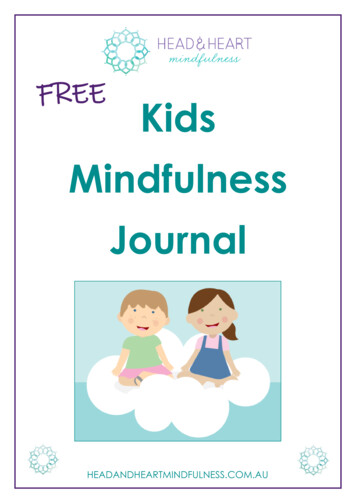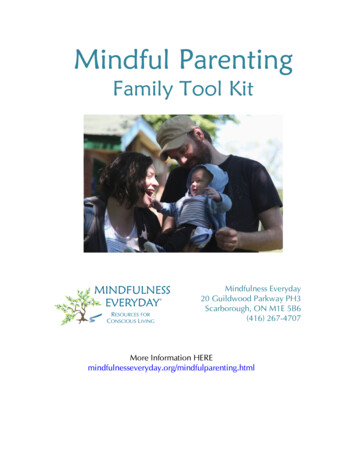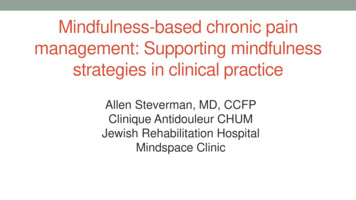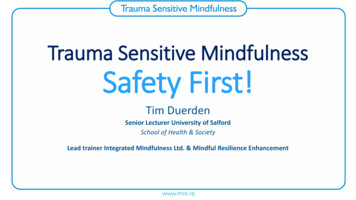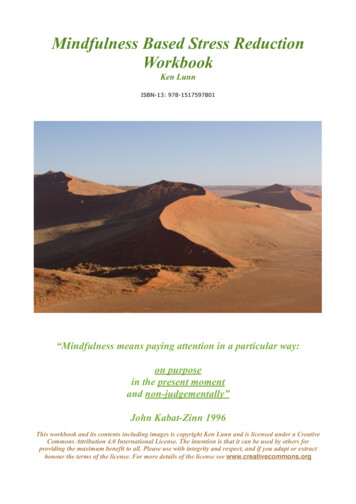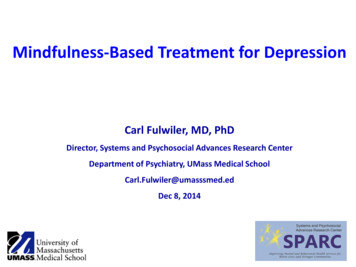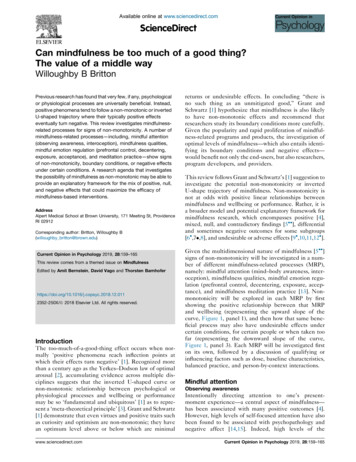
Transcription
Available online at www.sciencedirect.comScienceDirectCan mindfulness be too much of a good thing?The value of a middle wayWilloughby B BrittonPrevious research has found that very few, if any, psychologicalor physiological processes are universally beneficial. Instead,positive phenomena tend to follow a non-monotonic or invertedU-shaped trajectory where their typically positive effectseventually turn negative. This review investigates mindfulnessrelated processes for signs of non-monotonicity. A number ofmindfulness-related processes—including, mindful attention(observing awareness, interoception), mindfulness qualities,mindful emotion regulation (prefrontal control, decentering,exposure, acceptance), and meditation practice—show signsof non-monotonicity, boundary conditions, or negative effectsunder certain conditions. A research agenda that investigatesthe possibility of mindfulness as non-monotonic may be able toprovide an explanatory framework for the mix of positive, null,and negative effects that could maximize the efficacy ofmindfulness-based interventions.AddressAlpert Medical School at Brown University, 171 Meeting St, ProvidenceRI 02912Corresponding author: Britton, Willoughby B(willoughby britton@brown.edu)Current Opinion in Psychology 2019, 28:159–165This review comes from a themed issue on MindfulnessEdited by Amit Bernstein, David Vago and Thorsten 0112352-250X/ã 2018 Elsevier Ltd. All rights reserved.IntroductionThe too-much-of-a-good-thing effect occurs when normally ‘positive phenomena reach inflection points atwhich their effects turn negative’ [1]. Recognized morethan a century ago as the Yerkes–Dodson law of optimalarousal [2], accumulating evidence across multiple disciplines suggests that the inverted U-shaped curve ornon-monotonic relationship between psychological orphysiological processes and wellbeing or performancemay be so ‘fundamental and ubiquitous’ [1] as to represent a ‘meta-theoretical principle’ [3]. Grant and Schwartz[1] demonstrate that even virtues and positive traits suchas curiosity and optimism are non-monotonic; they havean optimum level above or below which are minimalwww.sciencedirect.comreturns or undesirable effects. In concluding “there isno such thing as an unmitigated good,” Grant andSchwartz [1] hypothesize that mindfulness is also likelyto have non-monotonic effects and recommend thatresearchers study its boundary conditions more carefully.Given the popularity and rapid proliferation of mindfulness-related programs and products, the investigation ofoptimal levels of mindfulness—which also entails identifying its boundary conditions and negative effects—would benefit not only the end-users, but also researchers,program developers, and providers.This review follows Grant and Schwartz’s [1] suggestion toinvestigate the potential non-monotonicity or invertedU-shape trajectory of mindfulness. Non-monotonicity isnot at odds with positive linear relationships betweenmindfulness and wellbeing or performance. Rather, it isa broader model and potential explanatory framework formindfulness research, which encompasses positive [4],mixed, null, and contradictory findings [5 ], differentialand sometimes negative outcomes for some subgroups[6 ,7 ,8], and undesirable or adverse effects [9 ,10,11,12 ].Given the multidimensional nature of mindfulness [5 ]signs of non-monotonicity will be investigated in a number of different mindfulness-related processes (MRP),namely: mindful attention (mind–body awareness, interoception), mindfulness qualities, mindful emotion regulation (prefrontal control, decentering, exposure, acceptance), and mindfulness meditation practice [13]. Nonmonotonicity will be explored in each MRP by firstshowing the positive relationship between that MRPand wellbeing (representing the upward slope of thecurve, Figure 1, panel 1), and then how that same beneficial process may also have undesirable effects undercertain conditions, for certain people or when taken toofar (representing the downward slope of the curve,Figure 1, panel 3). Each MRP will be investigated firston its own, followed by a discussion of qualifying orinfluencing factors such as dose, baseline characteristics,balanced practice, and person-by-context interactions.Mindful attentionObserving awarenessIntentionally directing attention to one’s presentmoment experience—a central aspect of mindfulness—has been associated with many positive outcomes [4].However, high levels of self-focused attention have alsobeen found to be associated with psychopathology andnegative affect [14,15]. Indeed, high levels of theCurrent Opinion in Psychology 2019, 28:159–165
160 MindfulnessFigure 1sadness, anxiety, panic, traumatic flashbacks, and clinicalpain syndromes [23–27], and all of these effects have beenreported in the context of mindfulness meditation training[7 ,9 ,11,12 ,19,28]. Further confirming the role of bodyawareness in increasing arousal in meditation, a recentRCT found that body-focused interoceptive training (bodyscan, breath awareness) produced the largest cortisol stressreactivity compared to other forms of meditation [30].The Inverted U-Shaped ss qualitieslowexcess[MINDFULNESS-PROCESS]highCurrent Opinion in PsychologyIllustrates an inverted U-shaped relationship between mindfulnessrelated processes (MRP) (horizontal axis) and wellbeing (vertical axis).Panel 1 shows how low levels or deficiencies in MRPs correspondwith low levels of wellbeing. It also shows how wellbeing increases asthe deficiency in MRPs is reversed. Panel 2 illustrates how optimallevels of MRP corresponds to maximal levels of wellbeing. Panel3 depicts how an excess of an MRP, past what is optimal,corresponds to a reduction in wellbeing.Mindfulness qualities are attitudinal factors that are considered an essential foundation for mindfulness practice [31].While present-moment awareness may constitute the ‘what’of mindfulness, mindfulness qualities constitute the ‘how’[16] by balancing that awareness with qualities of nonjudgment, acceptance, curiosity, open-mindedness, optimism,self-efficacy, courage, trust, patience, persistence, kindness,empathy, generosity, gratitude, social intelligence, freedom,autonomy, and choice. While it is hard to imagine ever havingtoo much of any of these qualities, Grant and Schwartz [1]demonstrate that all of these usually beneficial qualities arenon-monotonic, or can have undesirable costs in certainsituations, for certain people or when taken too far.Mindful emotion regulationEmotion regulation and prefrontal controlobserving awareness facet of mindfulness have beenrepeatedly found to be associated with worse mentalhealth, including increased depression, anxiety, dissociation, and substance abuse [8,16] and decreased ability totolerate pain [17]. However, a few studies have suggestedthat the correlation between observing awareness andnegative outcomes is reduced when observing awarenessis correlated with non-judgment and non-reactivity, qualities that are often (but not always) considered essentialdimensions of mindfulness [8,16].Mindfulness training has been found to increase prefrontalcontrol over the limbic system and amygdala, which isassociated with improved emotion regulation, anxiety,depression, and emotional reactivity [22,32]. However, highlevels of prefrontal control of the amygdala can be associatedwith global emotional blunting and dissociation [33]. Indeed,meditation-induced dampening of the amygdala has beenfound to attenuate not just negative emotions but positiveones as well [34,35]. Multiple studies have found thatmindfulness meditation training can result in reduced intensity, blunting, or complete loss of both positive and negativeemotions and dissociation in some people[9 ,12 ,33,34,36]Interoception and the insula cortexBecause deficits in interoception and insula cortex hypoactivation are associated with many forms of psychopathology,mindfulness training is hypothesized to bring about beneficial effects by increasing interoception or body awarenessand insula activation [13,18]. In support of this hypothesis,mindfulness-related increases in body awareness are associated with greater wellbeing for chronic pain patients whotend to avoid their bodies [19]. Increases in the size andactivation of the insular cortex have been found to resultfrom both short-term and long-term meditation trainings,and correlate with the amount of practice [20–22]. However,while reversing interoceptive deficits may confer wide-ranging and transdiagnostic benefits, this does not mean thathigher levels of interoception or insula activation beyonddeficit reversal will continue to confer increasing benefit.High levels of interoception and/or insula activation areassociated with a wide range of undesirable effects, includingincreased arousal and emotional intensity, depression,Current Opinion in Psychology 2019, 28:159–165Decentering and psychological distanceAn essential part of mindful emotion regulation is decentering—the ability to ‘step back’ or to have psychologicaldistance from instead of fusion with one’s experience,especially one’s thoughts and emotions [13,37]. Decentering has been found to mediate some mindfulnessrelated increases in wellbeing [38]. However, mindfulness shares some neurobiological correlates with dissociation, including high parasympathetic tone, prefrontalcontrol over the amygdala (discussed above), and activation of the inferior parietal lobe (IPL) [33]. Farb et al. [39]hypothesize that mindfulness training recruits the IPL’sdissociative functions (out-of-body experiences anddepersonalization) to create mindfulness’s ‘detached orobjective mode of self-focus’ or the ability to switch froma 1st to 3rd person perspective. Given this overlap withdissociation, how does one ensure that mindfulnesswww.sciencedirect.com
Can mindfulness be too much of a good thing? Britton 161produces the optimal level of psychological distance that‘steps back’ far enough but not too far?Exposure and experiential avoidanceBy intentionally and consistently using an ‘approachorientation’ [37], ‘turning toward the difficult,’ andexperiencing one’s negative emotions fully, mindfulnessis thought to exert transdiagnostic benefits by ‘facilitatingextinction of distress in response to strong emotions,leading to reduced emotional avoidance and, consequently, disorder symptoms’ [40]. Drawing from empirical evidence that many disorders are caused and maintained by high levels of experiential avoidance, exposuretheory predicts and has verified that those who benefit themost reduce high levels of experiential avoidance bydeliberately attending to threat [41]. However, anxietyand other disorders can be caused and maintained notonly by attentional bias away from (avoidance of) threat,but also by attentional bias toward threat [41,42]. Consequently, the most effective treatment will be the one thatcorrects the baseline problem. Avoidant individuals havebeen shown to benefit from exposure (attending tothreat), while those with bias toward threat benefit mostfrom cognitive bias modification (CBM), or training attention away from threat [41,42]. Thus, not only is exposureineffective for those who are negatively biased, trainingattention toward threat in non-avoidant populations hasalso been found to increase rather than decrease anxietyin both adults and children [41,43,44]. Thus, the benefitsand/or harms of exposure depend on the initial baselinelevel of the targeted problem (bias toward or away fromthreat), and can become either ineffective or iatrogenicwhen applied to people with levels different than thetargeted one [29].Acceptance and reappraisalMindful emotion regulation seeks to increase adaptiveapproach-related strategies like acceptance and reappraisal, and seeks to decrease maladaptive, avoidantstrategies like distraction and suppression [13,37]. However, treating any one strategy as either consistentlyadaptive or maladaptive has been called ‘the fallacy ofuniform efficacy’ [45]. Depending on the context and theperson, favored strategies such as acceptance and reappraisal may be superior, inferior, or equal to disfavoredstrategies such as suppression and distraction [46] and aresometimes associated with adverse effects [47,48]. Forexample, re-appraising or accepting a situation can easedistress when there are no other options, but failing totake corrective action in a situation one could havechanged can cause depression [47]. Thus, “few, if any,psychological processes are inherently and alwaysadaptive” [47, p. 7]. Instead, the utility and benefit ofany psychological process is dependent on the interactionbetween person and context.www.sciencedirect.comMindfulness meditation practice amountThe relationship between meditation amount and wellbeing shows signs of non-monotonicity, or a combinationof positive, null and negative effects. In a review ofmindfulness-based interventions (MBSR and MBCT),Parsons et al. [49] found that 25% of the studies reportedsignificant positive relationships between mindfulnesspractice amount (up to 45 min per day) and positivepsychological or physical health outcomes. For threequarters (75%) of the studies, the correlation betweenpractice amount and outcomes was not significant, andsome studies found a significant relationship betweenpractice amount and negative outcomes [49]. For example, Britton et al. [50,51] found an inflection point belowwhich meditation practice was sleep-promoting andabove which sleep-inhibiting. Low practice amounts inMBCT participants increased sleep duration, but as practice amount approached 30 min per day, sleep durationand depth began to decrease and cortical arousal (awakenings and microarousals) began to increase. Long-termmeditators have also been found to have poorer sleep thannon-meditators, with cortical arousal that is linearly correlated with lifetime meditation practice amount [52].Thus, if one is seeking to improve sleep through mindfulness meditation, limiting rather than increasing practice may be the best recommendation. Similar findingshave been found for gratitude practice, where less practice (once per week) was more effective for promotingwellbeing than more practice (three times per week) [53].Mindfulness-related processes, nonmonotonicity, and influencing factorsLike most other psychological processes, the above examples suggest that at least some MRPs are likely nonmonotonic. That is, they are usually beneficial but undercertain conditions, for certain people, or at certain levels,their effects can turn negative, have costs, or have undesirable effects. Considering non-monotonicity across multiple domains of mindfulness above also generated several testable hypotheses about conditions where nonmonotonic positive and negative effects may be mostlylike to arise, as well as several ‘influencing factors’ thatcould moderate the effect.DoseAccording to the inverted U-shaped curve principle, toomuch-of-a-good-thing-type adverse effects are caused bythe same mechanisms and processes that also yield benefits. This model would predict that negative effectscould occur with correct practice, and would be morelikely at higher doses of practice or MRP. However, thelocation of inflection points could be further influencedby the following additional factors.Baseline characteristicsThe non-monotonicity model also predicts that bothpositive and negative effects will be more likely to occurCurrent Opinion in Psychology 2019, 28:159–165
162 MindfulnessTable 1Indications, contraindications, and potential adverse effects for different mindfulness-related processesProcessIndications (deficiency reversal)Contra-indications (excess-causing) Potential adverse effects (signs ofexcess)Self-observationLow self-awarenessHigh self-focus, especially withoutother mindfulness dimensions [8]acute stress, health crisis [6 ]Interoception/insulaLow body awareness, lowemotional awarenessPoor emotion regulation, highemotional reactivityLow psychological distance(high fusion with thoughts oremotions), lack of perspectiveHigh experiential avoidanceHigh body or emotion awarenessEmotion regulation/prefrontalcontrolPsychological distance anddecenteringExposure (attending to threat)Emotional control, flat affect,dissociative tendenciesNormal to high psychologicaldistance, dissociative tendenciesLow experiential avoidance,negative attention bias [41,42]Anxiety, depression, dissociation,substance abuse,8,[7 ,8,9 ,11,12 ,16];increased symptom distress, socialavoidance, decreased quality of life [6 ]Anxiety, flashbacks, stress reactivity,pain [9 ,11,12 ,30]Emotional blunting, dissociation [9 ,34]Dissociation, depersonalization, out-ofbody experiences [9 ,12 ,36]Negative attention bias, anxiety,depression [6 ,7 ,40]Table 1 maps select mindfulness-related processes horizontally across the inverted U-shaped curve. The column labeled ‘indications’ represents theupward slope (Figure 1, Panel 1), where the deficiency of the mindfulness process is reversed and the corresponding impact on wellbeing is likely toincrease. The ‘contraindications’ column refers to the downward slope (Figure 1, Panel 3), where the amount of the mindfulness-process hassurpassed optimal levels and is beginning to have costs. The indications and contraindications columns contain hypothesized subgroup informationpredicted by the inverted U-shaped curve model. The potential adverse effects columns contain references to mindfulness studies that foundnegative or adverse effects that could be explained by excesses in the corresponding mindfulness-process.in practitioners with particular baseline conditions: positive effects would be most likely to occur in those withlow levels (deficits) of MRPs, while negative effectswould be most likely to occur in those with high baselinelevels of MRPs. Table 1 displays these findings in termsof potential indications, contraindications and possiblenegative effects for the MRPs included in this review.Balanced practiceHigh levels of a specific MRP may produce negativeeffects on its own, but can be counterbalanced by supplementing with other MRPs. While research has foundthat observing awareness can be balanced by non-judgment [8,16], additional research may benefit from investigating other combinations, for example: how interoception may counterbalance decentering to preventdissociation, or how exteroception (awareness of surroundings) may counterbalance exposure to preventflooding [29].mindfulness and wellbeing. Rather than ignoring ordownplaying null or negative results, non-monotonicityprovides an overarching and testable explanatory framework for the mix of positive, null and negative effectsfound in mindfulness research. The framework valuesnull and negative effects because they signify boundarycondition violations or inflection points. These are important because they provide otherwise unavailable information about optimal versus ineffective or harmful doses ofMRPs under different conditions or for different people.Thus, a comprehensive knowledge of both positive andnegative effects would help maximize the effectivenessand minimize the harms of the practice, as well as provideindicators of when other approaches or counterbalancesmight be warranted. Researchers [1,54] have recommenda non-monotonic research agenda that asks: how much ofeach mindfulness process is too much, and when donegative effects occur? However, a number of existingpractices create barriers to the necessary knowledge ofthe full range of effects.Person-by-context interactionInteraction between all of the above factors could besummarized by a person-centered orientation: how muchof which MRP is optimal for this specific person in thisspecific situation, according to this person’s goals andvalues? “Mindfulness cannot be fully understood as ‘moreis better, less is worse.’ . . . Rather, its how the differentmindfulness skills combine in a person that may be mostimportant for his or her mental health” [8, p. 363].Positivity biasNon-monotonic research agendaRange restrictionInvestigating the potential for the non-monotonicity ofmindfulness has several advantages over assuming aubiquitous, positive and linear relationship between“When researchers fail to discover non-monotonic relationships, the methodological artifact of range restrictionmay be the culprit” [1, p. 71]. In other words, the rangeCurrent Opinion in Psychology 2019, 28:159–165Mindfulness studies tend to overrepresent positiveresults, while negative findings are either not publishedor obscured by post-hoc subgroup analyses or creative reinterpretations [55,56 ,57 ]. In addition, very few MBItrials actively measure adverse effects [58 ], relyinginstead on passive monitoring, which can underestimatethe actual frequency by more than 20-fold [59,60].www.sciencedirect.com
Can mindfulness be too much of a good thing? Britton 163of measurement or sample may artificially truncate thefull range of possible values [1,54]. For example, themost frequently used measure of mindfulness [61], theMindful Attention Awareness Scale (MAAS) actuallymeasures deficiencies of mindfulness (i.e. it measuresmindlessness). Because it is measuring mindfulness inthe deficiency-reversal phase (Figure 1, Panel 1), but notin the excess phase of the inverted U-shaped curve, it ismore likely to be highly and linearly associated withgains in wellbeing or functioning and show few negativeeffects. Similarly, the range of meditation-relatedexperiences is often truncated by sample restriction.Most MBI studies use data only from the treatmentcompleters and lack data from long-term follow-upsand dropouts—the groups most likely to have negativeeffects [56 ,60]. Similarly, studies of meditationexperts—ostensibly representing the consequences ofhigh doses of meditation—are often prone to samplingartifacts that magnify positive traits. Long-term meditators who participate in research selectively representmeditators who still meditate, and not ex-meditatorswho no longer meditate because of negative or nulleffects [11]. Expert meditators with mental health issuesare typically excluded from research, resulting in aselective representation of the effects from long-termpractice [52].model that can chart a ‘middle way’ between ‘not enough’and ‘too much of a good thing.’Individual-level dataWhile a few studies have shown worse average outcomes(increased negative effects) for mindfulness training compared to control conditions [6 ,7 ,40,51], the use of meansand effect sizes typically obscures individual differencesand extreme scores [60]. Recommendations for improveddetection of negative effects include visual inspection ofdata, qualitative descriptions or detailed case studies ofoutliers, including reasons for attrition or noncompliance,and displaying outcome data in quartiles [54,60]. Usingthe Reliable Change Index [62], which describes data interms of clinically meaningful gains as well as deteriorations, is becoming required in high impact journals.ConclusionMindfulness researchers and program developers haverecognized that reversal of deficiencies in MRPs enhancewellbeing, but have paid less attention to how excesses inthese processes could also undermine wellbeing. In otherwords, the field of mindfulness has been primarilyfocused on the upward slope of the inverted U-shapedcurve, with insufficient attention to the downward slopeof the curve. A mindfulness research agenda that employsa non-monotonic framework—one that includes theentirety of the inverted U-shaped curve—may be betterpositioned to make sense of positive, null, and contradictory findings, differential outcomes for different subgroups, and negative effects. A non-monotonic framework will help to maximize effectiveness and minimizeharms in mindfulness-based applications by providing awww.sciencedirect.comConflict of interest statementNothing declared.AcknowledgementsThis work was supported by the National Institutes of Health (grant K23AT006328-01A1); the National Institutes of Health (NIH) Science ofBehavior Change Common Fund Program through an award administeredby the National Center for Complementary and Integrative Health (grantUH2AT009145). The views presented here are solely the responsibility ofthe authors and do not necessarily represent the official views of the NIH.I would also like to thank Jared Lindahl and Adam Grant for their helpfulfeedback.References and recommended readingPapers of particular interest, published within the period of review,have been highlighted as: of special interest of outstanding interest1.Grant AM, Schwartz B: Too much of a good thing: the challengeand opportunity of the inverted U. Perspect Psychol Sci 2011,6:61-76.2.Yerkes RM, Dodson JD: The relation of strength of stimulus torapidity of habit-formation. J Comp Neurol Psychol 1908,18:459-482.3.Pierce J, Aguinis H: The too-much-of-a-good-thing effect inmanagement. J Manage 2013, 39:313-338.4.Brown KW, Ryan RM: The benefits of being present:mindfulness and its role in psychological well-being. J PersSoc Psychol 2003, 84:822-848.5. Van Dam NT, van Vugt MK, Vago DR, Schmalzl L, Saron CD,Olendzki A, Meissner T, Lazar SW, Kerr CE, Gorchov J et al.: Mindthe hype: a critical evaluation and prescriptive agenda forresearch on mindfulness and meditation. Perspect Psychol Sci2018, 13:36-61.This article is a consensus statement from 15 mindfulness researcherswho are concerned that the application of mindfulness-based interventions and products is outpacing the scientific evidence base. The reviewhighlights areas of concern and makes recommendations for how toimprove the rigor of the science and the safety of the interventions.6. Reynolds L, Bissett I, Porter D, Consedine N: A brief mindfulnessintervention is associated with negative outcomes in arandomised controlled trial among chemotherapy patients.Mindfulness 2017, 8:1291-1303.In a RCT of mindfulness training versus relaxation training for cancerpatients undergoing chemotherapy, mindfulness (but not relaxation)training was associated with increased symptom distress, social avoidance and reduced quality of life. The authors caution against using MBIsduring the acute stage of illness.7. Johnson C, Burke C, Brinkman S, Wade T: Effectiveness of aschool-based mindfulness program for transdiagnosticprevention in young adolescents. Behav Res Ther 2016, 81:1-11.One of the largest school-based mindfulness randomized controlled trials(RCTs) to date, comprises of more than 300 students across five schools.Compared to normal school activities, mindfulness training resulted inincreased anxiety for males, and for students of both genders with lowbaseline depression or weight concerns.8.Sahdra B, Ciarrochi J, Parker P, Basarkod G, Bradshaw E, Baer R:Are people mindful in different ways? Disentangling thequantity and quality of mindfulness in latent profiles andexploring their links to mental health and life effectiveness. EurJ Pers 2017, 31:347-365.9. Lindahl JR, Fisher NE, Cooper DJ, Rosen RK, Britton WB: Thevarieties of contemplative experience: a mixed-methods studyCurrent Opinion in Psychology 2019, 28:159–165
164 Mindfulnessof meditation-related challenges in Western Buddhists. PLoSOne 2017, 12:e0176239.TheVarieties of Contemplative Experience study is the most comprehensive study on meditation-related challenges and difficulties to date.Based on interviews with more than 100 meditation teachers and meditators, the study documents 59 categories of meditation-related experiences that are often associated with negative valence, distress, orfunctional impairment.10. Lustyk M, Chawla N, Nolan R, Marlatt G: Mindfulness meditationresearch: issues of participant screening, safety procedures,and researcher training. Adv Mind-Body Med 2009, 24:20-30.11. Lomas T, Cartwright T, Edginton T, Ridge D: A qualitativesummary of experiential challenges associated withmeditation practice. Mindfulness 2014:1-13.25. Nardo D, Hogberg G, Flumeri F, Jacobsson H, Larsson SA,Hallstrom T, Pagani M: Self-rating scales assessing subjectivewell-being and distress correlate with rCBF in PTSD-sensitiveregions. Psychol Med 2011, 41:2549-2561.26. Craig AD: How do you feel—now? The anterior insula andhuman awareness. Nat Rev Neurosci 2009, 10:59-70.27. Martinez E, Aira Z, Buesa I, Aizpurua I, Rada D, Azkue JJ:Embodied pain in fibromyalgia: disturbedsomatorepresentations and increased plasticity of the bodyschema. PLoS One 2018, 13:e0194534.28. Brooker J, Julian J, Webber L, Chan J, Shawyer F, Meadows G:Evaluation of an occupational mindfulness program for staffemployed in the disability sector in Australia. Mindfulness 2013,4:122-136.12. Cebolla A, Demarzo M, Martins P, Soler J, Garcia-Campayo J:Unwanted effects: is there a negative side of meditation? A multicentre survey. PLoS One 2017, 12:e0183137.An online survey of 342 Spanish-speaking, English-speaking, and Portuguese-speaking meditators found that 25% of respondents reported‘unwanted effects’ (UEs) from meditation, including increased anxiety/panic (14%), pain/headaches (6%), and dissociation/depersonalization(9%). While most UEs were transitory, some UEs were long-lasting,required medical attention, and resulted in discontinuation of meditationpractice.30. Engert V, Kok BE, Papassotiriou I, Chrousos GP, Singer T:Specific reduction in cortisol stress reactivity after social butnot attention-based mental training. Sci Adv 2017, 3:e1700495.13. Holzel BK, Lazar SW, Gard T, Schuman-Olivier Z, Vago DR, Ott U:How does mindfulness meditation work? Proposingmechanisms of action from a conceptual and neuralperspective. Perspect Psychol Sci 2011, 6:537-559.32. Tang YY, Holzel BK, Posner MI: The neuroscience ofmindfulness meditation. Nat Rev Neurosci 2015, 16:213-225.14. Ingram RE: Self-focused attention in clinical disorders: reviewand a conceptual model. Psychol Bull 1990, 107:156-176.15. M
Intentionally directing attention to one's present-moment experience—a central aspect of mindfulness— has been associated with many positive outcomes 4 However, high levels of self-focused attention have also been found to be associated with psychopathology and negative affect [14,15]. Indeed, high levels of the Available online at www.sciencedirect.com ScienceDirect www.sciencedirect .
